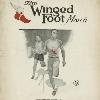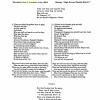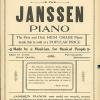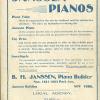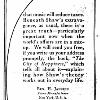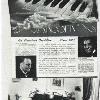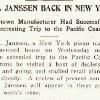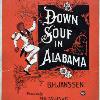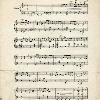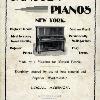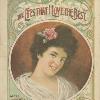Ben Janssen, a “big, good-natured, cheerful giant” prolific composer and lyricist and a sought-after toastmaster who often addressed his audience in verse, must have been one of the more gregarious residents at the Grinnell in its first decade. The founder and owner of the Janssen piano – Made by a Musician, for Musical People – moved to the Grinnell shortly after it opened in 1911, bringing with him the title “America’s Waltz King,” a title he may well have invented for himself to help sell his pianos, because in addition to his other talents, Janssen possessed marketing genius.
Bernard H. Janssen was born in Oldenburg, Germany August 31, 1862 and arrived in America with his parents the following year, in the midst of the American Civil War. He anglicized his name early on, probably during his school days, using Bernhard only rarely (mainly for public documents), preferring B. H., Ben H. or Ben for his compositions and business associations.
Music was not Janssen’s first choice of profession. After he completed his schooling, he attempted a career on the sea, but soon abandoned that idea, apparently because he was prone to sea-sickness. Although the brief biographical sketches of Janssen that appeared during his lifetime do not mention any particular aptitude for music, around 1883, at the age of 21, he began managing a piano store and five years later had become secretary at the Mathushek and Son Piano Company. During that same decade, he began publishing his compositions, mainly music for the piano or songs for solo voice with piano accompaniment.
Marriage and Early Family Years
With a steady salary from Mathushek supplemented by income from the songs he wrote, he began a family, marrying Gertrude (Gertie) Anderson in the late 1880s. The Janssens had a daughter, Elsa Katherine, in 1893 and a son, Webster, in 1899. Whether for the benefit of the children’s health, or because the Janssens were moving up in the world socially and financially – Janssen’s most popular songs appeared during the 1890s – shortly after Webster’s birth Janssen moved his family from 356 West 51st Street to Herkimer County. They remained there less than a year, and then, in 1901, moved back to Manhattan where Janssen began manufacturing his own pianos in a factory on Park Avenue at 128th Street.
Only five years later, The Music Trade Journal described Janssen as exceeding all his friends’ expectations and planning to produce 1500 pianos in 1907. Asked the secret of his success, Janssen replied:
“I’ve put in a lifetime with the best houses in the trade, always studied how to make a piano that would be high grade and yet could be sold at such a price that the dealer would see some real money in the way of profits before he died of hard work, worry, and nervous prostration.”
Janssen also mentioned that he needed a larger factory. That same year, the B. H. Janssen Piano Company bought an in the Bronx bounded by the Southern Boulevard, 132 Street, Brown Place, and Brook Avenue, where Janssen built a large fireproof factory building. Moving his piano factory uptown and across the river prompted Janssen to find a new home for his family, so after a couple of years at 172 West 105th Street, he brought them to the newly-opened Grinnell, where they would remain more than a decade, years during which Janssen built upon his reputation, traveled the country developing new outlets for his pianos, and constantly tried new marketing techniques.
Marketing the Janssen Piano
In the era before the phonograph and radio were ubiquitous in American homes, a piano was not only a sign of solid middle-class respectability, it was also a primary source of music in the home, particularly in homes removed from an urban center where live musical performances ranging from vaudeville to symphony orchestras were more accessible. And even in urban centers, the easiest way for a music lover to reproduce the latest popular song or a piece performed on the concert stage, was to buy the music and play it on the piano; piano reductions of orchestral music (often for four hands, a handy adjunct to courtship) and sheet music for popular tunes abounded. Those without musical training or aptitude could entertain themselves with a player piano or a “reproducing” piano that played roles a famous pianist had created, reproducing not only the notes, but also the dynamics and apparently a reproduction of the pianist’s unique sound.
In response to a demand for home pianos that began in the mid-19th Century, scores of small piano manufacturers sprang up, an abundant supply forcing individual manufacturers to find innovative ways to grab a share of the market and build brand loyalty. Ben Janssen’s reputation as an excellent judge of piano sound, a manufacturer of solid, affordable pianos, and an honest businessman earned him several elected positions in the National Piano Manufacturers’ Association of the United States, including president, but in the crowded world of piano manufacturers at the beginning of the 20th Century, he needed an extra advantage if his company was going to compete. Janssen was a brilliant marketer. His initial approach reflected the dual concepts of reliability and personal honor, both implicit in the Janssen Creed:
This is my creed and on it I have built my Piano and Reputation! To give you as nearly as possible a dollar's value for every dollar you give me. To treat you as I want to be Justly. Since you may possibly know little or nothing about the material or craftsmanship that goes into the piano you bought, you must naturally rely on me. I want you to do that-and I promise that your confidence shall not be misplaced. Following this creed for a lifetime, has earned a Janssen reputation, that my product and methods must maintain. I want to be right and do right. If I fail in any one thing, it will never be because I wanted to.
Accompanying the Janssen Creed was a constant stream of ads. The earliest, appearing in trade journals and home magazines like “Ladies Home Journal” were small boxes covering 1/16th of a page, with slogans such as “The Janssen: Right in Every Way,” “The Home Piano of America,” and “Made by a Musician, for Musical People.” In trade journals, when these appeared on a page with a dozen other ads, some taking a quarter of a page, Janssen differentiated his company with the simple, though apparently unknown technique, of white text on a black or red background, his ads “popping” out from a page of black on white. Later ads showed Janssen pianos in beautifully-furnished rooms along with slogans such as “A Top-Grade Piano at a Not-Top Price.”
The Janssen models had classic (and classy) sounding names such as Colonial, Moderne, Georgian, Louis XV, and the 18th Century Mignon, names a proud owner might drop into conversation: not just a piano, but the Janssen Louis XV.
After Janssen established his piano business, he created the M. D. Janssen Publishing Company to publish his songs, the inside cover and back cover being full page ads for Janssen Pianos and the bottom of each inside page carrying an advertisement for another B. H. Janssen song – “ask your dealer to show you a copy.” He also crafted an agreement with “Ladies Home Journal” to publish some of his songs, along with advertisement for his pianos.
In 1920 , apparently as an antidote to the malaise and lowered morale following WWI, Janssen commissioned newspaperman Alfred Hovey Ballard to write a 14-page book entitled “The City of Happiness,” a book combining motivational thoughts and music appreciation: “stop worrying, and straining, and doubting, and grouching.” A series of Janssen piano ads over the next few years, offered a free copy of the book to anyone who wrote the Janssen Piano Company requesting on or who visited a Janssen piano dealer. What was the “key to solving life’s problem”? Fill your life with music. Though the book does not explicitly mention the Janssen piano – indeed, the Janssen name only appears in the book once, on the copyright page (Ben, H. Janssen, 1920) – it clearly drew potential customers into stores selling Janssen pianos and spread the Janssen name, the book’s uplifting message building good will for the company.
The Janssen Piano and Innovations
Besides producing upright pianos and spinets for the home, Janssen produced “miniature grands,” and in 1919, introduced the Janssen-Angelus, a piano that combined the Janssen piano and the “Angelus player action, manufactured by Wilcox & White Co., Meriden, Conn., one of the oldest and best-known mechanisms in the world.” player pianos and player grands, as well as reproducing and expression player pianos, the kind that captured a performance along with dynamics and tempo. The Janssen Spinet was deemed “the smallest full-keyboard spinet piano in the world with standard Direct-Blow Action.”
Among Janssen Company’s innovations was the “built-in Music Desk Light,” a fluorescent light installed at the manufacturer, directly below the music, a device that saved both eyes and energy since no other lights were necessary in the room; and it was effective as a de-humidifier to protect the “piano's delicate inner mechanism.” One of Janssen’s more intriguing innovations was The Janssen Chord Piano, featuring a system of colored lights that enabled “anyone, regardless of age, to sit down and have fun at the piano without ever having had a lesson.”
B. H. Janssen’s Later Years
The Roaring ‘20s brought many changes to the Janssen household and in Janssen’s business. Already in 1919, Janssen’s son Webster, a WWI veteran – he had been a Navy aviator despite being in his teens – had begun “taking a most active part in the management of the business…relieving his father of many of the details.” Then, in September 1920, Gertie Janssen’s died while at Henderson Harbor, New York. After her death, Ben and his children moved to 230 West 76th Street, where they were living in 1927, the year both Elsa and Webster were married. By the end of the ‘20s, Webster had taken charge of the Janssen Piano company, though Ben continued to travel, soliciting new business up to a few months before he died in 1933.
Three decades later, C. G. Conn bought the Janssen Piano Company. A few years later, in 1969 Charles R. Walter, head of Piano Design and Developmental Engineering at Conn bought the Janssen piano name and manufacturing facilities in the Bronx, bringing out the Charles B. Walter line of pianos in 1975 and eventually discontinuing the Janssen brand. The firm is still in business and still family owned. Continuing the high standards of the earlier Janssen Company, the firm produces only two thousand pianos a year, a family member inspecting and signing each piano before it leaves the factory.
 | ||||
 | ||||
 | ||||
 | ||||
 | ||||
Our History: Grinnell People in the News
B. H. (Ben) Janssen
Click images for a larger view
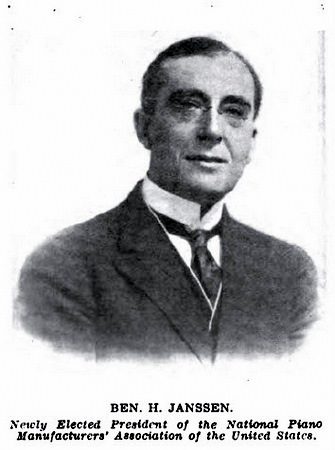
Spotlight on Grinnell
News-makers Past and Present
The residents of 800 Riverside Drive celebrating community, a unique sense of place, and an architectural gem
